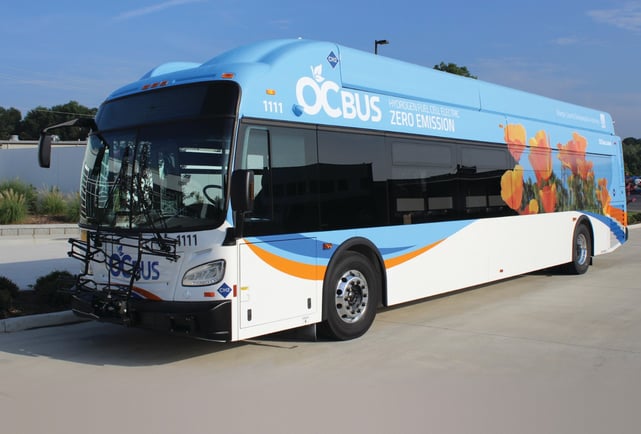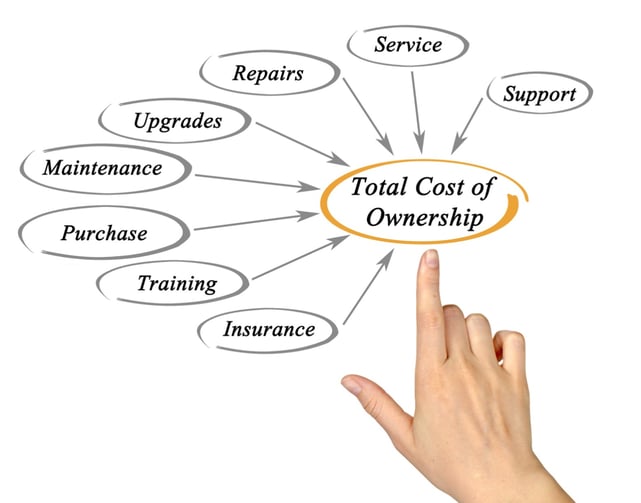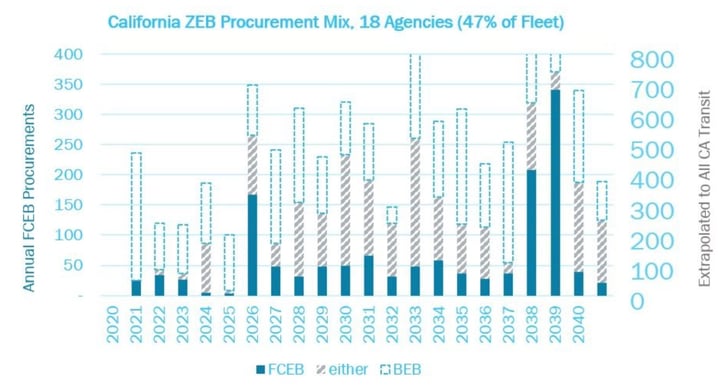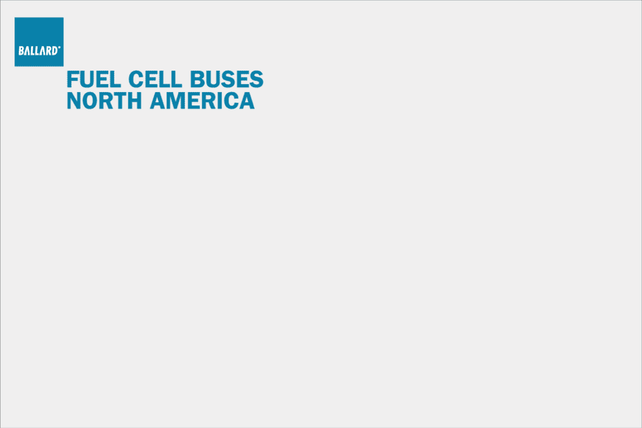Are you a transit fleet operator planning to convert to zero-emission buses in the coming years? Then this is the article for you.
You’ll learn why preparing a thorough transition plan early in the process is so essential to scaling your zero-emission fleet successfully—and why without such a plan, you’re likely to encounter roadblocks that are, largely, preventable. We’ll also share some key findings of other fleet operators as they developed their own plans to transition from diesel power to zero-emission buses (ZEBs).

 Ballard-powered fuel cell electric bus at Orange County Transportation Authority (OCTA)
Ballard-powered fuel cell electric bus at Orange County Transportation Authority (OCTA)
Designing your zero emission bus rollout plan: The first step to an effective transition
California's Innovative Clean Transit (ICT) regulation mandates that, beginning in 2029, 100% of new bus purchases by transit agencies must be zero emission, with a goal of achieving a complete transition to ZEBs by 2040.
Furthermore, by 2026, 50% of procurements must be ZEB for large transit agencies, and 25% must be ZEB for small transit agencies. Prior to beginning this significant transition, transit agencies are required to prepare a detailed rollout plan, which basically outlines what the options are, and how to limit the hurdles you’ll encounter in the process.
This kind of long-range planning is essential for an effective rollout. It forces operators to consider all the impacts the zero-emission transition will impose. Designing service and maintenance facilities and refueling infrastructure for ultimate capacity, for example, are critical considerations.
There are unfortunately numerous cases where short-range planning, with early purchases and partial solutions has resulted in service shortfalls, and transitional pain that extends throughout the entire organization. Without thorough planning, pilot projects will likely result in a return to the drawing board.
The learnings from the California ICT roll out plans will be very beneficial to other agencies in the US and Canada.
An effective transition plan considers:
- a phased rollout that looks years into the future.
- a series of incremental steps that build to a final system capacity.
- a clear roadmap for adapting to new ZEB technology.
Perhaps the most critical aspect of the plan is the mix of ZEB technologies: will you choose a single ZEB technology, or a mix of fuel cell electric buses (FCEB) and battery electric buses (BEB)? The choice of BEB and FCEB technologies affects route planning and service levels. The need for recharging and refueling systems determines the kind of infrastructure upgrades you will require.
 Ballard-powered fuel cell electric buses from New Flyer and Sunline Transit agency.
Ballard-powered fuel cell electric buses from New Flyer and Sunline Transit agency.
Four factors to consider when planning your mix of fuel cell and battery electric buses
1. Which technology best serves your routes?
Battery electric buses provide adequate service on shorter, less demanding routes. Their range is approximately 150 miles (250km) at best, and less when the route includes steep hills.
Fuel cell electric buses have a similar range to diesel and CNG buses. They are the choice for longer routes, and routes with hills and heavy loads.
2. What is the projected total cost of ownership (TCO) of each technology?

Purchase price is only one factor in a technology’s TCO. It’s also essential to include the recharging/refueling infrastructure and maintenance:
- Battery recharging equipment for BEBs adds to the total system cost, as do the additional megawatts or tens of megawatts of electrical infrastructure that may be required to power the rechargers as the fleet grows.
- Hydrogen refueling infrastructure for FCEBs has a similar footprint to CNG refueling. There are various flexible and scalable options: hydrogen can be delivered in gas or liquid form to refueling depots, or it can be produced on-site, and marginal costs decrease as fleet size grows.
3. What is the cost of any required infrastructure upgrades?
To maintain and service BEBs and/or FCEBs, maintenance facilities will have to be upgraded. In many cases, current safety codes and standards will affect the design and cost of the upgrades. (Learn more in our blog How to Adapt Your Bus Depot to Refuel and Service Hydrogen Fuel Cell Buses.)
Plus there is the added layer of complexity as the local electrical utility may not have the available power in your neighbourhood. If you’re considering BEBs, it’s important to determine how to manage the cost of substation upgrades, and their associated timelines.
4. How can you plan for the unexpected?
When planning your transition, try to design a system that will be adaptable to change. For example, the first small pilot fleets of BEBs have recently tried to scale their services to meet the changing needs of passengers.
They quickly encountered the limitations of mass electrification and the complexity of the electrical grid, and changing passenger demands demonstrated the need for fleet flexibility. The changing passenger demands that the COVID-19 pandemic has introduced over the past year have made this flexibility all the more important.
An overview of ZEB rollout plans: What technologies are California transit agencies choosing?
In California, eighteen rollout plans have been released to date, representing nearly half of the Californian fleet. All but two of those plans include FCEBs as essential or potential components. Of the ZEB procurements planned for 2020 to 2040, the breakdown shows a mix of FCEBs and BEBs:
- 24% of procurements designated as FCEB.
- 46% designated as BEB.
- 31% are open to either.
 The Californian ZEB procurement plans show a mix of FCEBs and BEBs
The Californian ZEB procurement plans show a mix of FCEBs and BEBs
In fact, if all agencies considering FCEBs are to commit, over half of all ZEBs in California will be powered by fuel cells. Here are some examples of agencies who favored FCEBs in their rollout plans, for a variety of reasons ranging from superior range and route capabilities to lower overall costs.
- Golden Empire Transit in Bakersfield chose an all-FCEB plan. They found: “operating one type of vehicle offers significant benefits to the agency as all buses can be operated and maintained efficiently and economically. It also means the buses are interchangeable and can be dispatched on any route as required.”
- Long Beach Transit has two depots. One will be all-FCEB, and the other will be all BEB. They state: “more difficult routes with higher energy demands will be serviced by FCEBs, which have demonstrated longer ranges.”
- Omnitrans in San Bernardino plans to use FCEBs for demanding routes: “For the specific routes which route-modeling has identified as not capable of being served by existing BEB technology, it is recommended that FCEBs be considered.”
- SunLine Transit Agency is a pioneer in zero-emission bus deployments, particularly for hydrogen FCEBs. Their plan calls for a fleet composition that is 85% FCEBs, a ratio that “was determined to maximize performance and minimize cost.”
- Orange County Transportation Authority (OCTA) who already operate FCEBs, chose an all-FCEB plan, stating: “general BEB operations would require cooperation from other agencies to install charging infrastructure along bus routes, making operation more complicated and potentially affecting service reliability”.
- Foothill Transit ran an operating costs projection for a 20-bus fleet of FCEBs over a twelve-year lifecycle. They found that the FCEB lifecycle cost is 21% less—or almost $13M cheaper—than a comparable BEB fleet. To match the service level of 20 fuel cell buses, they would need 34 battery buses. In addition, the battery-electrical infrastructure investment was 2.5 times more expensive than the hydrogen refueling infrastructure.
 Map of fuel cell electric bus deployments in North America
Map of fuel cell electric bus deployments in North America
Further resources to assist with your planning
The California Air Resources Board (CARB) ICT Rollout Plan site contains a wealth of information and insights on ZEB introductions. Any fleet operator, anywhere in the world, can learn from the plans, and in some cases, the missteps that have been made along the way. Reviewing the feasibility studies from third-party consultants also provides useful information, and many of these can also be accessed on the ICT Rollout Plan website.
Final thoughts

There is no time to lose. Zero-emissions mandates such as the ICT in California and carbon-neutrality mandates across the US and Canada require action today to have the vehicles and infrastructure in place in time to meet them.
And while transit operators must act quickly, it’s essential to have a detailed plan in place before doing so. Such a plan will ensure you use your resources most effectively as you scale up, allowing you to transition to a fully operational fleet of zero-emission buses as quickly and smoothly as possible.
Fuel Cell Electric Buses - Proven Performance and the Way Forward
This informational is packed with data from Ballard-powered fuel cell electric buses operating in North America and Europe. You'll also learn more about range, durability, operational costs, and expected improvements.
